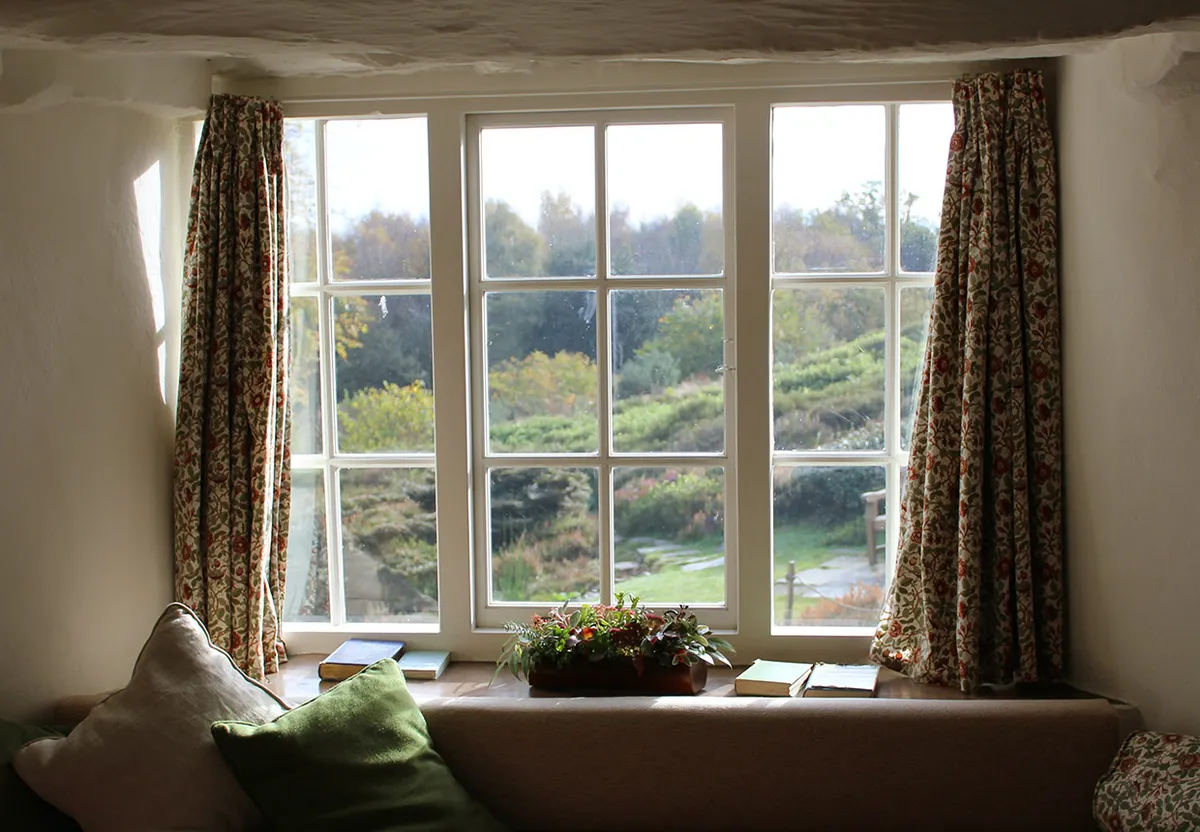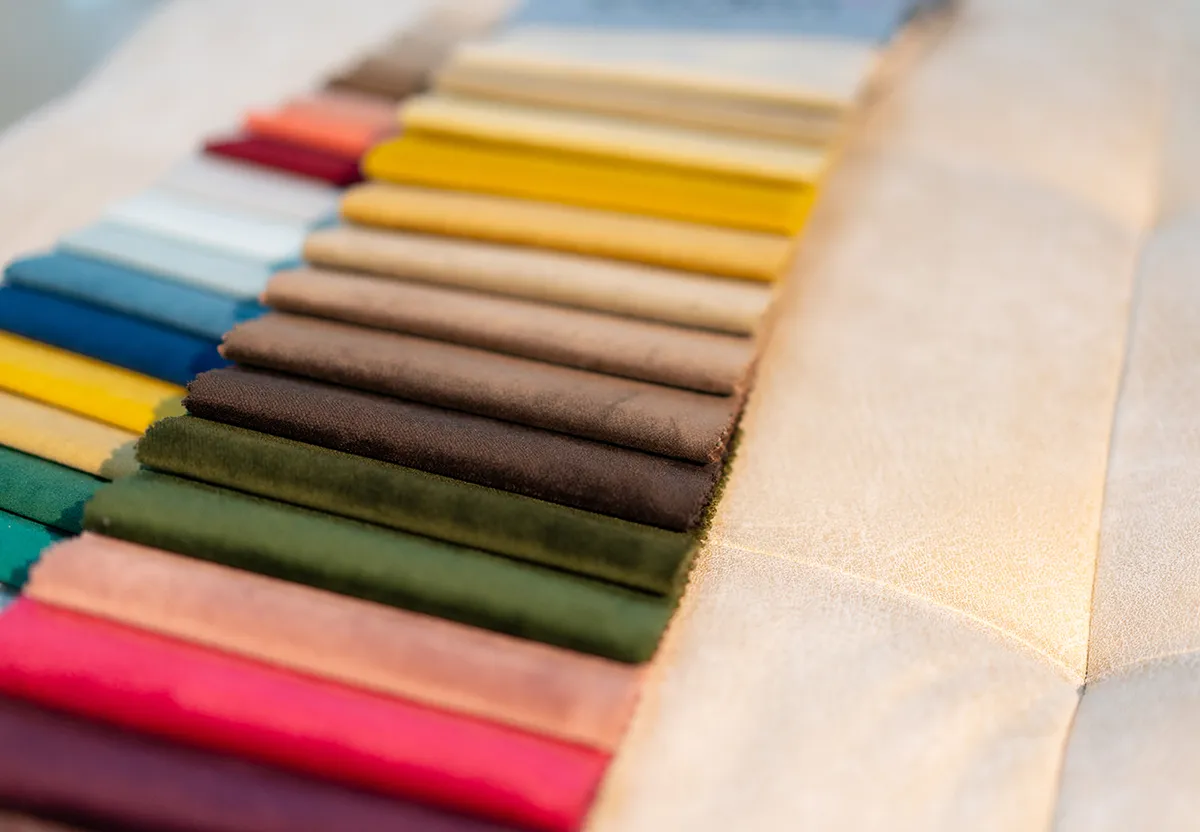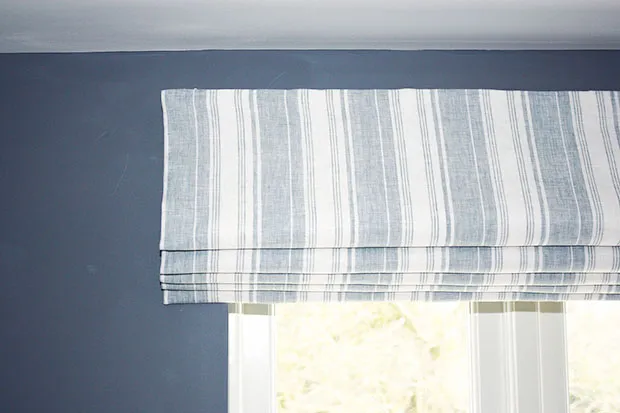There are few greater joys in life for us than flicking through a book of fabric swatches, or better, getting up close with bolts of fabric in an actual store. If you're just starting out with upholstery, or you're looking to buy some fabric to make curtains, blinds or sturdy homewares, this article is for you.
With thousands of different types and styles of upholstery fabric out there, what should you look out for when you're picking the right one for your home? We'll dive into this question, and explore what you can use upholstery fabric for and where can you it. We've asked experts who work with upholstery fabrics every day to share their useful tips to help you to find the right upholstery fabric for your project.
Upholstery is the art of covering or repairing furniture with fabric, padding, springs or leather, but this isn't the only use for upholstery fabric. The kind of upholstery fabrics we find in shops aren't just used for traditional upholstery – they can also used to make curtains, blinds and other soft furnishings, from covering bed boards to footstools or making seat cushions.
Traditional upholstery is on the rise here in the UK, according to a recent survey of the nation's craft habits. It's a craft with historical origins (we do love a bit of craft history) – the word itself comes from the Middle ages, and is rooted in the original word "upholder" – meaning an artisan who made fabric furnishings. It really took off in the 18th century, when the Elizabethan era saw a rise in demand for comfort in home furnishings. Upholsterers were called upon by the wealthy to add padding, springs and soft touches like cushions to hard furniture in their homes.
Just as the project you need to use upholstery fabric for will vary, so will the type you need... and the price. Upholstery fabrics can be pricey, but there are more budget options too. We'll talk you though what to look for...
This article includes:
- What is upholstery fabric?
- What can you use upholstery fabric for?
- How to buy upholstery and curtain fabric – what to look for
- Different types of upholstery fabric
- Where to buy upholstery fabric
You might also like our tutorials for How to make curtains and How to make roman blinds. Main image: Anastasiia_Guseva
What is upholstery fabric?
Upholstery fabric is, simply put, fabric or textiles that you can use to cover furniture or make soft furnishings like blinds and curtains. It can be made from woven or knitted threads to make textiles, and it comes in a huge range of fibre types – from cotton to linen, polyester, velvet, polyester, polypropylene or rayon to name a few.
Melanie Yurt runs That's Well Lush – a London-based bespoke blind-making business. She uses upholstery fabrics to make blinds and curtains for her clients. She admits, "it's mind-blowing how many different types of upholstery fabric there are" at first. From man-made options to linen, velvet and cotton, she's made blinds out of pretty much every fabric out there. We've asked her to share her tips in this post.
Melanie reports seeing surges in demand for different types of fabric, "linen and velvet fabrics are very popular at the moment," she reveals. One thing to consider when shopping for fabric will be how you can handle it when you craft with it. "Be careful of anything with a synthetic mix if you're making curtains or blinds," she advises – you'll need to be really wary of going near it with an iron! Synthetic fabrics do have benefits though – it's highly durable, often more affordable and can withstand stains.
To find the right fabric for you, the first question is, what do you need it for? Then we'll look into the different fabric types, and share our favourite places to buy.

Shopping for upholstery fabric? We've got you covered. Photo © Anastasiia Stiahailo
What can you use upholstery fabric for?
So initially we all start out expecting upholstery fabric to be for... well upholstery of course. The most common craft that people think of when they think of upholstery fabrics is the covering of furniture items with fabrics to repair or transform the way they look.
But over the years, a thriving industry has evolved for everyone looking to use upholstery fabrics for all sorts of other homewares. You can use upholstery fabrics to make curtains, blinds or to cover smaller homewares like footstools or seat cushions.
If you're upholstering a seat or sofa which will be in the heart of a busy family home, the fabric you pick will need to withstand a high amount of use compared to a roman blind for example. Here we'll look at how to buy upholstery fabric to find the right type for your project.
This article focuses on the two main most common uses of upholstery fabric - using it for upholstering furniture or making soft furnishings.

How to buy upholstery and curtain fabric: what should you look out for?
"Honestly it is very hard to choose a fabric," admits Melanie. "There are so many options out there! I have clients that apologise for taking ages to decide but I completely understand as it took two years to finally decide to go for the Kitty McCall fabric in my lounge! I feel rather sentimental about our back bedroom blind – I made it from a random piece of a honeycomb weave-printed 70s tablecloth I found at a vintage stall in Peckham. Love the colours."
But never fear, we've listed a few things to consider when shopping for fabric – it's much better to research thoroughly before you commit as once you've chosen, you'll likely be living with the fabric you choose for years.
Fabric weight and durability
The first thing to ask yourself is – what do you need the fabric for (we're guessing if you're reading this article, you'll already have a good idea about this). Your intended use will affect how hard-wearing you need your fabric to be.
Upholstered furniture will often live in a busy room of the house - your living room or family room, and if you're upholstering an item which is going to be well-used by all the family, look out for a fabric which will stand the test of time – you'll need a tightly woven, durable fabric as not only will it need to not withstand damage. If you're making curtains or blinds, your fabric won't need to withstand as much but it helps the drape and finished look to use a heavier weight. You may also need to add a layer of lining.
If you're in a shop browsing upholstery fabrics, look out for a high thread count. More tightly woven materials will be more durable. You can test how strong the weave is by holding and pulling a sample tightly in both directions, to see how tightly woven the threads are.
If you're working on traditional furniture upholstery projects, check what's called a "rub test" – otherwise know as the martindale value of the fabric. This value is worked out by rubbing a material repeatedly until it shows signs of wear and tear. Textiles with a low rub counts (less than 10,000 rubs) are used for more decorative sewing projects, for example scatter cushions or throws. Fabrics with higher martindale values will be sturdier and last longer.
We've asked Jane Evans, who runs Third Person Upholstery, for her advice about finding the right fabric for upholstering furniture."Really I wouldn't choose to upholster anything in a fabric with a Martindale much below 25,000." she explains, "As well as it not being very hard wearing, it may lack structural integrity, and may prove challenging to work with – stretching, snagging etc.."
Print or pattern
Obviously this affects the finished style of your project, but if you're making curtains or blinds or bigger projects, you'll also need to consider pattern matching – this will affect how much fabric you need to buy. If you pick a fabric with a large repeating print, and you're making a wide curtain or blind, you may need to pattern match two or more pieces, so you'll need to check the measurement of the repeat print. The odds are, you'll need to buy extra fabric to allow for pattern repeat.
Stain resistance
It's safe to say, we all live in homes with a different risk level of spillages. (Red wine on the sofa fans – we're looking at you.) If you're looking for fabric to decorate furniture in a home where young children like to play, bounce and climb, it's a wise idea to look for an upholstery fabric which can be cleaned if the worst does happen. Synthetic blends like microfiber are designed to more easily cope with spillages and stains.
If you've got your heart set on a fabric which isn't stain-proof, it's also possible to treat some fabrics with an upholstery protector spray. This article has more advice on how to treat fabric to prevent stains.
Equally, if you've fallen in love with natural fabrics, one way to insure yourself just against the impact of future stain risk is by opting for a busy print – that way if the worst does happen, any marks will be more easily obscured by the fabric pattern. As with any home furnishing choices, if you want cream linen but live with a toddler, just be aware of the future risks when you buy!
Price
There are so many different price points for Upholstery fabric – prices start at £25–£30 a metre up to £100 a metre or higher. Again, the project you are working on will affect how much you need to spend, with traditional furniture upholstery fabrics needing higher quality material. "The trouble is, upholstery fabrics are more expensive," explains Jane. "You may spot a lovely Liberty printed cotton, which sells for less than £30 a meter, but to buy that same print in a linen suitable for upholstery –with a rub count of 20,000, you're looking at having to spend £150 a meter." Ouch!
Never fear though, we've got some more affordable options below if you're looking for simple home furnishing fabrics that don't need to be highly durable.
"If you're on a tight budget, Ikea do some brilliant cheap upholstery fabrics," recommends Melanie. We trust her advice on this – we used it ourselves when we brought fabrics for a roller blind recently! She has other tips for shopping affordably too, "If you've got your eye on high end brands, look out for sample sales." House of Hackney (in Shoreditch, London) usually retail for £130 a metre but they do sample sales once or twice a year where you can pick up beautiful fabrics for a discount."
Allergies
We know dust allergies are a real thing – this author lives with a son who suffers from them! It's worth researching the qualities of the fabric you are shopping for, to consider how it's going to react to dust. Fabrics with short fibres are less likely to attract dust or pet hairs. While man-made fabrics seem like they will be less likely to cause allergies, in reality natural fibres like cotton, linen and silk are hypoallergenic, too. Check the label as you shop and look out for fabrics marked as "hypoallergenic."
Fire safety
If you're upholstering furniture, especially if you run a small business and are making furniture for clients' homes, you'll need to consider fire regulations. For more detail on this, see the Furniture and Furnishings Fire Safety Regulations Act 1988.
"Essentially, fabrics that contain a minimum of 75% natural fibres need to be treated (or "FR'd") – most upholstery fabric suppliers will offer this service, sometimes at cost. If not, you will need to fit a fire-resistant interliner or barrier cloth.
Strangely the law states that this only applies to the re-upholstery of furniture made since 1950.
What are the different types of upholstery fabrics?
Broadly speaking there are two type of upholstery fabric – natural and synthetic. Natural fabrics come from plants and animals, for example cotton canvas, linen or leather, while synthetic fabrics are man-made, and include polyester and microfibre. Here are a few of the main types:
Linen upholstery fabric
- Pros: strong, durable, luxurious finish, well suited to heirloom furnishings
- Cons: creases easily, stains easily, tricky to handle
There are some great durable linens out there for upholstery, and it's antistatic too. "There are some lovely un-dyed natural linens out there," explains Melanie. "You can use them for blinds but you have to be very careful how you handle them as they're essentially slippery, so you need to pin them well to secure them. Just like other fabrics made from natural fibres, linen will be less stain-resistant but it's a beautiful choice for heirloom pieces and will make truly beautiful blinds too.
Velvet upholstery fabric
- Pros: soft, luxurious, cosy, stylish, doesn't crease
- Cons: Can wear or fade quickly, can be difficult to clean
Velvet fabrics are enjoying a boom in popularity, both for curtain fabric and upholstery. Velvet has short tufts of cut threads, which create a dense pile which gives a soft, cosy feel. It's great for texture fans. There's a whole range of velvets out there to choose from – traditional velvets are more cotton-based while you can get synthetic versions that are fade-resistant. This article from Yorkshire Fabric Shop has more information on the different types of velvet upholstery fabrics.
Synthetic or man-made upholstery fabric
- Pros: Easy to clean, stain and fade resistant, often more affordable, highly durable
- Cons: Avoid ironing while making with it, can attract static, environmental questions around sustainability (read more on this here)
If you're looking for durability, Microfiber is one of the toughest upholstery fabrics you could opt for, apart from leather. It's made from ultra fine, polyester fibres, and unlike leather it has a softer feel. If you're shopping with resistance to wear and tear in mind, look out for 100% polyester fabrics – they'll be stain-resistant, are less likely to fade and will be easy to clean. They do have to be carefully handled while you're making homewares with them though – be very careful with your iron and check the fabric care instructions before you even attempt to press.
Leather
When we think about upholstered furniture, leather has to be one of the most traditional, classic materials we think of. It's popularity over the years is due to it's durability and classic style. It's tough, durable but softens with age and wear, plus it is easy to keep clean. It's also often the most expensive fabric option, and is understandably not an option for vegetarians and vegans. It can also feel sticky in hot weather and you may need to treat or clean it (special kits are available, like this one from John Lewis).
Where to buy upholstery fabric – UK
There are many ways of buying fabric – you can buy every day upholstery fabrics for curtains or blinds easily online or locally from a fabric store. For traditional furniture upholstering, or if you're sourcing fabric for a bigger project or small business, you can also go direct to a specialist fabric supplier or furniture manufacturer. By going directly to the fabric supplier or manufacturer, you'll benefit from their in depth expertise about their fabric collection.Building up relationships with local fabric suppliers could mean they'll share tips or advice about the best fabric for you. We'll start with some easy places to find upholstery fabrics online below, and then share tips from Jane and Melanie about their favourite suppliers.
John Lewis upholstery fabric
- Shop the range: John Lewis Furnishing Fabrics (from £10.50 a metre).
Always top of our go-to places for online fabric shopping, They don't have the biggest upholstery fabrics range but have some great extras in this online store alongside the main fabrics – if you're making blinds for example you can stock up on linings too. We really like their option to order a free fabric swatch and if you scroll down to product specifications, they include detail about the size of the pattern repeat to allow you to calculate your yardage required.
Ikea upholstery fabric
- Shop the range: in store or browse online: Ikea Fabric collection (from £2 a metre)
Ikea's upholstery fabrics are actually a great choice if you're on a tight budget but want a modern fabric, with some beautiful scandi prints in the collection. They don't have a huge range of upholstery fabrics but a small and highly affordable collection, which if you can find the right one to match your decor, are great value for money. These are the budget end of the upholstery fabric range but we like that they supply information about the sustainability of each fabric, and if you're able to get to a store, we recommend trying to go in person to check them out before buying online, as their website doesn't provide huge information about each fabric's weight and qualities – so you might want to go and feel for yourself before you buy.
Spoonflower upholstery fabric
- Shop the range: Spoonflower Upholstery Designs
Our favourite for affordable range of designs, Spoonflower has some really beautiful upholstery fabrics in their collection, an all the designs are by independent designers who profit from every sale. Shop here if you love print and pattern – Spoonflower have got the lot from modern geometric prints to mid-century, or Art Nouveau designs. As with any online fabric shopping, we recommend ordering a swatch before you commit as it's really hard to get a feel for the fabric qualities online. You can order a £2 swatch
Ebay
- Shop the range: Ebay upholstery fabrics
One for all you bargain hunters! "Check on eBay for second hand upholstery fabrics" advises Mel. You can snag some real gems if you're willing to put in the time to researching. "You can sometimes get great curtains that can be reused too. Very cheap way to get a lot of fabric but bear in mind you might need to get dry cleaned sometimes."
Next upholstery fabric
- Order a free swatch: Next Upholstery Fabrics
A more mainstream choice than the Spoonflower print range, Next have some really great stylish Upholstery fabrics in their collection, with some beautiful textures and types from faux leather to velvets and tweedy blends in neutral, low-tone shades and checks. This probably isn't the place to shop if you love an eye-catching print or colour-popping shade, but if you want understated fabric to make your own home furnishings, take a look and you can order free swatches before you commit to buy.
Upholstery fabric specialist suppliers – tips from the pros
Mel's tips for buying blind or curtain fabric
"I always recommend getting swatch samples so you can properly see and feel the fabric – colour representation isn't great on screen. You can also get a better idea of the feel and weight of the fabric. I get clients to see how the fabric looks with the different lining options"
- Tinsmiths – www.tinsmiths.co.uk/fabric.html – quite classic and traditional upholstery fabrics. Includes St Judes, which is folk-inspired patterns and William Morris
- Lorna Syson – lornasyson.co.uk - a local lady to me in Peckham, she has a studio in Deptford and now supplies to John Lewis
- Safo Masi Original – www.safomasi.com/rugs-fabric/fabric-by-the-metre.html – quirky illustrated prints for fabrics and homewares.
- Cloth House – www.clothhouse.com – if you are ever in Soho in London, this place is gorgeous. I can't trust myself in there! Great linens but again can be bit pricey.
- Just Fabrics – www.justfabrics.co.uk Worth a look through. Huge selection from plains to some more contemporary geometric fabrics.
- Tamasyn Gambell – www.tamasyngambell.com/collections/fabric-by-the-meter screen printed by a small family-run factory in Europe using water-based pigments. Beautiful patterns but at the higher price end.
- The Swedish Fabric Company – www.theswedishfabriccompany.com A range of modern Scandinavian fabrics.
- Kitty McCall – www.kittymccall.com/collections/fabric – Tropical and abstract brights in bold colours.
- Fabrics and Papers – www.fabricsandpapers.com Huge range of designer fabrics.
- Sian Elin – www.sianelin.com Graphic, bold prints.
- Modelli Fabrics modellifabrics.com Huge range.High quality upholstery fabric at a suitable price
- Madder Cutch and Co – www.maddercutchandco.com Quality linens with plant based dyes.Hand printed.
- Ottoline – www.ottoline.co.uk/fabric High end price points. Bold patterns in subtle colours
- Soane – www.soane.co.uk/fabrics-wallpapers Fabrics are made in British mills and workshops, employing traditional methods, such as block and screen printing, to create high quality modern fabrics that capture the atmosphere of hand crafted products.Prices on request from company, high price bracket.
- Zobo – www.zobodesigns.com/collections/fabrics Designed and made in the UK. Cotton and linen fabric with a luxurious, raw feel. Smaller new textile designer.
Jane's tips for buying upholstery fabric
"Entry into the world of buying upholstery fabrics can be challenging as a new business," says Jane. "To get a trade account you may need a number of references, else you'll need to buy through an approved stockist, who may also scrutinise you. Prices may not be on hand, you'll have to request those from the stockist, so there can be a lot of admin and time spent emailing back and forth, when you just want to order a few metres of fabric."
- Linwood is a great all rounder – beautiful prints, quality velvets – linwoodfabric.com
- Christopher Farr has a great range of designers, including Bauhaus textile artist Anni Albers – christopherfarrcloth.com
- It's always good to find a fun independent like www.poodleandblonde.com/
- Or a local textile designer like www.tamasyngambell.com/pages/about-us
- Or a made-to-order textile from a hand made lino cut www.sylviaandmargot.com

